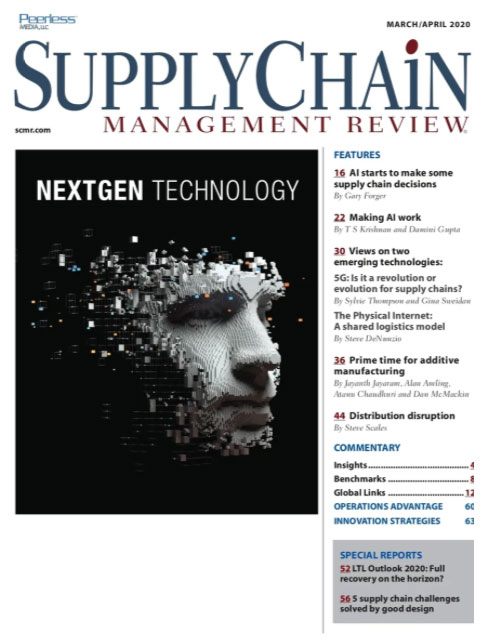Sorry, but your login has failed. Please recheck your login information and resubmit. If your subscription has expired, renew here.
March-April 2020
Are you ready for NextGen technologies? Just the other day, I had the opportunity to tour one of Amazon’s highly automated robotic fulfillment centers. I expected to be dazzled—and I was. But it wasn’t because of the automation. The tour was a reminder that there’s no question that NextGen technologies such as Artificial Intelligence, blockchain, robotics, 3D printing and 5G are going to be the differentiators in tomorrow’s supply chain. The question is: Are you ready? Browse this issue archive.Need Help? Contact customer service 847-559-7581 More options
Digital transformation has the potential to deliver staggering improvements in operational performance. Companies clearly understand this. The IDC Spending Guide predicts that global investments in digital transformation will reach $2.3 trillion in 2023. A substantial portion of those investments will be devoted to building digital supply chains.
At this point, most supply chain organizations have evaluated an array of available technologies including advanced robotics, 3D printing, AR/VR and advanced data science. Many have hired top digital talent, crafted ambitious digital supply chain strategies and launched multiple pilots.
Why, then, does real progress remain so elusive? In truth, many supply chain leaders seem dissatisfied with the pace and impact of their digital transformations, as mounting investments are stubbornly slow to yield breakthroughs in supply chain performance.
The problem is not with the technology, which often proves effective in pilots. The big challenge is successfully scaling up. Pilots that succeed in a single location create tremendous initial excitement, then fail to prove out the projected value across the broader enterprise. Such failures breed skepticism and drain precious momentum from the transformation effort.

This complete article is available to subscribers only.
Log in now for full access or start your PLUS+ subscription for instant access.
SC
MR
Sorry, but your login has failed. Please recheck your login information and resubmit. If your subscription has expired, renew here.
March-April 2020
Are you ready for NextGen technologies? Just the other day, I had the opportunity to tour one of Amazon’s highly automated robotic fulfillment centers. I expected to be dazzled—and I was. But it wasn’t because… Browse this issue archive. Access your online digital edition. Download a PDF file of the March-April 2020 issue.Digital transformation has the potential to deliver staggering improvements in operational performance. Companies clearly understand this. The IDC Spending Guide predicts that global investments in digital transformation will reach $2.3 trillion in 2023. A substantial portion of those investments will be devoted to building digital supply chains.
At this point, most supply chain organizations have evaluated an array of available technologies including advanced robotics, 3D printing, AR/VR and advanced data science. Many have hired top digital talent, crafted ambitious digital supply chain strategies and launched multiple pilots.
Why, then, does real progress remain so elusive? In truth, many supply chain leaders seem dissatisfied with the pace and impact of their digital transformations, as mounting investments are stubbornly slow to yield breakthroughs in supply chain performance.
The problem is not with the technology, which often proves effective in pilots. The big challenge is successfully scaling up. Pilots that succeed in a single location create tremendous initial excitement, then fail to prove out the projected value across the broader enterprise. Such failures breed skepticism and drain precious momentum from the transformation effort.
SC
MR


Latest Supply Chain News
- ‘Purple People’ and the evolution of supply chain talent
- Looking for the next frontier of margin enhancement? Think structurally
- ISM May Semiannual Report calls for growth in 2024, at a reduced rate
- Augmented reality’s role in upskilling the workforce
- Supply chain salaries top $100K for first time
- More News
Latest Podcast

 Explore
Explore
Software & Technology News
- ‘Purple People’ and the evolution of supply chain talent
- Augmented reality’s role in upskilling the workforce
- Inflation continues to have a wide-ranging impact on supply chains
- Technology’s role in mending supply chain fragility after recent disruptions
- Tech investments bring revenue increases, survey finds
- Survey reveals strategies for addressing supply chain, logistics labor shortages
- More Software & Technology
Latest Software & Technology Resources

Subscribe

Supply Chain Management Review delivers the best industry content.

Editors’ Picks






